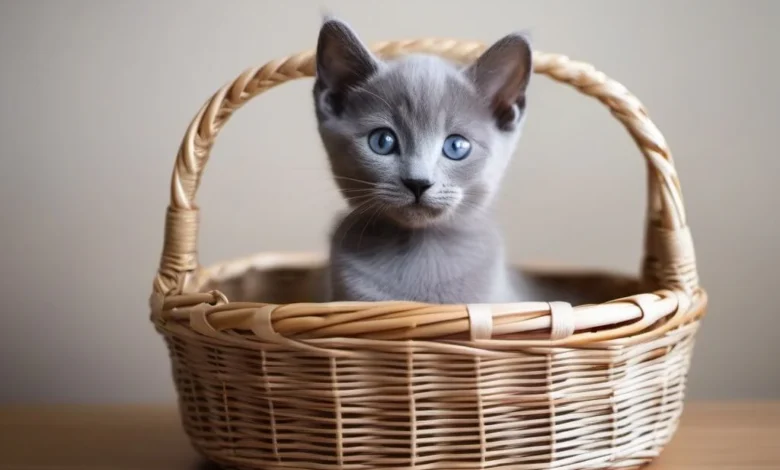The Graceful Russian Blue Cat: A Comprehensive Guide

The Russian Blue cat, known for its stunning silvery-blue coat, captivating green eyes, and gentle demeanor, is one of the most elegant and sought-after feline breeds. With a history steeped in mystery and a personality that wins hearts worldwide, this breed has carved a unique niche among cat enthusiasts. In this article, we will explore the origins, physical characteristics, personality traits, health considerations, and care tips for the Russian Blue cat.
Origins and History
The exact origins of the Russian Blue cat are shrouded in mystery, but the breed is believed to have originated in the Archangel Isles in northern Russia. Sailors are thought to have brought these cats to Europe in the 1860s, where they quickly gained popularity due to their beauty and grace.
Initially exhibited in England under the name “Archangel Cat,” the Russian Blue competed alongside other blue-coated cats. By the early 20th century, breeders began to develop distinct traits for the breed, emphasizing its shimmering coat and striking green eyes. After World War II, when the breed’s population dwindled, breeders in Britain and Scandinavia worked to preserve and enhance the Russian Blue’s unique qualities, ensuring its survival and prominence.
Today, the Russian Blue is recognized by major feline organizations worldwide and continues to captivate cat lovers with its beauty and charm.
Physical Characteristics
The Russian Blue cat is a medium-sized breed, known for its slender, muscular build and poised appearance. Below are the defining physical features of this breed:
Coat: The Russian Blue’s double-layered coat is one of its most distinctive features. The dense, plush undercoat is covered by soft, silky guard hairs tipped with silver, giving the cat a shimmering appearance. Unlike other breeds, their coat has a velvety texture, which is a delight to touch.
Color: The coat’s uniform blue-gray hue is unique and contributes to the breed’s name. This coloration extends to their nose leather and paw pads, which are also gray.
Eyes: Russian Blues have large, almond-shaped eyes that are an intense, vivid green. Kittens are born with yellow eyes, which gradually turn green as they mature.
Body Structure: These cats have a graceful, athletic build with long legs, a straight back, and a well-proportioned body. Their ears are large and pointed, adding to their alert and intelligent appearance.
Personality and Temperament
Russian Blue cats are renowned for their sweet, affectionate nature. While each cat has its unique personality, the following traits are commonly associated with the breed:
Affectionate and Loyal: Russian Blues form strong bonds with their families and are often described as “people-oriented.” They enjoy being near their owners but are not overly demanding.
Gentle and Quiet: These cats have a soft voice and are known for their quiet demeanor. They’re unlikely to cause disruptions, making them ideal companions for those who prefer a peaceful home environment.
Intelligent and Playful: Highly intelligent, Russian Blues are quick learners who enjoy puzzle toys and interactive games. Their playful side ensures they stay active and engaged.
Shy Around Strangers: While they are deeply loyal to their families, Russian Blues can be reserved or cautious around unfamiliar people. Socializing them early can help them feel more comfortable in different settings.
Routine-Oriented: These cats thrive on routine and can become stressed with significant changes to their environment or daily schedule.
Health and Lifespan
The Russian Blue cat is generally a healthy breed with a lifespan of 15 to 20 years, provided they receive proper care. However, like all breeds, they are prone to specific health issues:
Obesity: Due to their love of food, Russian Blues are susceptible to weight gain. Owners should monitor their diet and provide regular exercise to maintain a healthy weight.
Genetic Disorders: While rare, some lines of Russian Blues may carry hereditary conditions. Reputable breeders screen for these issues to ensure the health of their cats.
Dental Health: Like all cats, Russian Blues require dental care to prevent gum disease and tooth decay. Regular brushing and dental check-ups are recommended.
By providing regular veterinary care, a balanced diet, and a safe, stimulating environment, owners can help their Russian Blue lead a long and healthy life.
Care and Maintenance
Taking care of a Russian Blue cat is relatively straightforward, thanks to their low-maintenance nature. Here are some essential care tips:
Grooming: Despite their plush coat, Russian Blues do not shed excessively. Weekly brushing is sufficient to remove loose hairs and maintain their coat’s silky texture. During shedding seasons, more frequent grooming may be required.
Diet: A high-quality diet tailored to their age, size, and activity level is essential. Avoid overfeeding, as these Russian Blue Cat are prone to gaining weight.
Exercise and Enrichment: Provide toys, scratching posts, and climbing structures to keep your Russian Blue active and entertained. Regular playtime also strengthens the bond between you and your cat.
Environment: Russian Blues thrive in a calm and stable environment. Ensure they have cozy spaces to relax and hide, especially if your household is busy or noisy.
Socialization: Early socialization helps Russian Blues feel comfortable with new people, pets, and environments. Positive reinforcement and patience are key during this process.
Fun Facts About Russian Blue Cats
Hypoallergenic Qualities: While no cat is entirely hypoallergenic, Russian Blues produce lower levels of the allergenic protein Fel d 1, making them a better choice for some allergy sufferers.
Nicknames: Due to their striking appearance, Russian Blues are sometimes called “Archangel Cats,” referencing their believed origin.
Royal Connections: Russian Blues were reportedly favorites of Russian czars and British royals, adding to their regal reputation.
Smile-Like Expression: The slightly upturned corners of their mouth give them a permanent “smile,” which many owners find endearing.
Longevity: With proper care, Russian Blues can live well into their twenties, making them a long-term companion for their owners.
Is a Russian Blue Cat Right for You?
Before bringing a Russian Blue cat into your home, consider your lifestyle and preferences. This breed is ideal for individuals or families who:
- Appreciate a calm and quiet companion.
- Have the time and willingness to engage in regular play sessions.
- Can maintain a consistent routine and environment.
- Are prepared for a long-term commitment, as these cats can live many years.
While Russian Blues are generally low-maintenance, they thrive best in loving, attentive homes where their needs are met.
Conclusion
The Russian Blue cat is a perfect blend of beauty, intelligence, and affection. Their serene nature, paired with their playful streak, makes them ideal companions for many households. Whether you’re drawn to their shimmering coat, vivid green eyes, or endearing personality, the Russian Blue is a breed that leaves a lasting impression. By understanding their history, characteristics, and needs, you can ensure a happy and fulfilling life for this enchanting feline.

